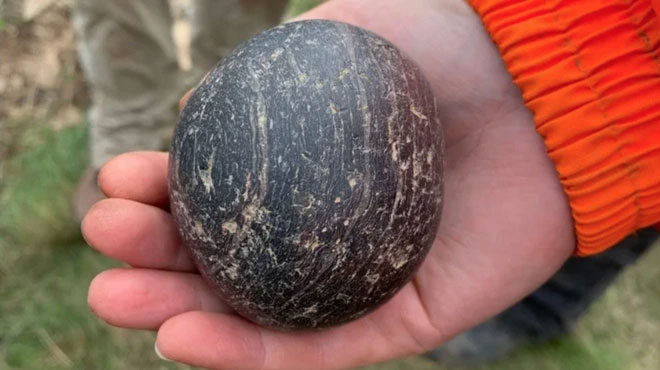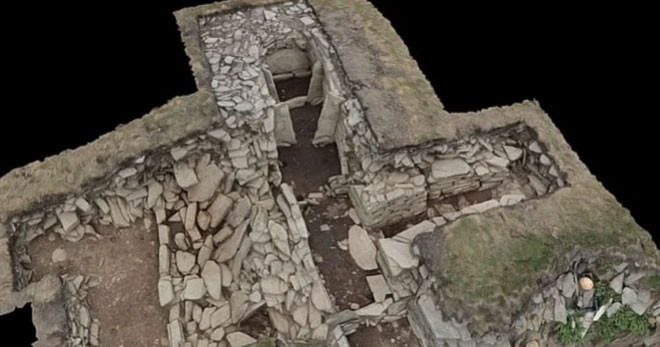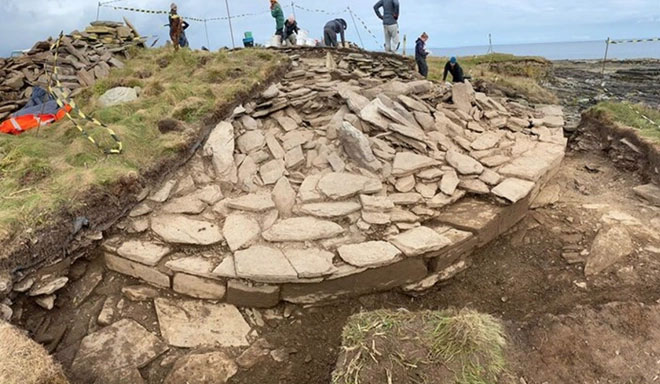Hundreds of stone balls have been discovered in a Neolithic burial site on Tresness, part of the Orkney Islands in Scotland, but no one knows what they were used for.
Each smooth stone ball, about the size of a baseball, has been found at Neolithic sites primarily in Scotland and the Orkney Islands, as well as in England, Ireland, and Norway. Some are intricately carved, such as the famous Towie ball discovered in northeast Scotland in 1860.

A mysterious stone ball. (Photo: University of Central Lancashire).
Researchers initially believed that these balls were used as weapons, which is why they are sometimes referred to as “mace heads.” Another theory suggests that a cord could have been wrapped around the carved lobes of some balls for throwing.
Archaeologist Vicki Cummings from the University of Central Lancashire in England, who led the excavation of the tomb on Sanday, stated that the stone balls might have been primarily made for artistic purposes, perhaps to signify a person’s status within their community or to commemorate an important life event.
Two stone balls found in the tomb near the beach at Tresness on Sanday—one made of black stone and the other from lighter limestone—are very early examples of such objects and are polished smooth, rather than carved like the Towie ball.
Cummings believes that carved balls tend to appear later in the Neolithic period, while polishing was more favored.
“The two polished balls are much simpler, but they are still beautiful objects. They would have taken quite a long time to make because polishing a stone is quite time-consuming. You have to sit there with some sand, some water, and a stone to finish the work,” the scientists noted.
The tomb was constructed around 5,500 years ago when the coastline was much farther away. It is now at risk of damage from storms.

Neolithic tomb. (Photo: University of Central Lancashire).
Cummings mentioned that this is one of the few instances where stone balls have been found in their actual context, which could shed light on the purpose of these mysterious objects.
Each ball was found at the corners of two different chambers used to place human remains in the burial chamber of the tomb, while other objects, particularly pottery shards, were found along the partition walls.
Inside the tomb, archaeologists also discovered a cache of cremated human bones near the entrance of two of the five chambers in the burial house, as well as several knives made by flaking beach pebbles into sharp-edged pieces. These knives might have been used to separate flesh from the bones of the deceased.
The archaeological work on the Neolithic tomb includes creating a detailed three-dimensional model from photographs taken at various stages of the site. Both polished stone balls were found in different chambers and may come from different burials. They are among the earliest items ever discovered.
The ancient tomb on Tresness is actually one of about 3,000 Neolithic sites on the Orkney Islands and is one of the earliest sites.
Other findings excavated from the recent tomb include cremated human bones and several pieces of pottery.
The Orkney Islands lie off the northernmost tip of mainland Scotland, scattered with archaeological sites, including the UNESCO World Heritage site known as the Heart of Neolithic Orkney surrounding the Ness of Brodgar complex and the Neolithic village of Skara Brae, indicating that the islands were densely populated about 5,000 years ago.
“The Orkney Islands may seem remote when you look at a map, but when you get here, you will find they are incredibly fertile agricultural land and very easy to farm. I think the Neolithic people came here and really thrived. They found an environment that they needed,” Cummings added.

Archaeologists excavating the Neolithic tomb.
The excavations on Sanday are a joint effort between the research team from the University of Central Lancashire, led by Cummings, and archaeologists from the National Museum of Scotland led by Hugo Anderson-Whymark.
Currently, the ancient tomb is located near the coast and is vulnerable to storm damage, so researchers are trying to learn as much as possible before the site is harmed.
The tomb and a Neolithic settlement they excavated about 1.6 km away would have been much farther from the coast 5,500 years ago, with a landscape that would have been more wooded than it is now.
Although the tomb was studied in the 1980s, superficial excavations did not accurately assess its true age.
In the most recent excavation, which took about four years to complete, researchers employed the latest archaeological techniques on the tomb, including creating a three-dimensional photogrammetric model of it.
Cummings noted that archaeologists will now proceed to analyze the data collected during the excavation, hoping to provide more information about the Neolithic people on this island.


















































